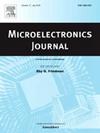A linearized PVT-robust FVF input buffer with triode transconductance feedback achieving SFDR > 90 dB at 500-MHz input
IF 1.9
3区 工程技术
Q3 ENGINEERING, ELECTRICAL & ELECTRONIC
引用次数: 0
Abstract
This paper presents a high-linearity input buffer leveraging triode-transconductance feedback (TTF) flipped voltage followers for RF sampling data converters. The proposed source follower incorporates a triode-biased transistor to enhance linearity by cancelling the third harmonic distortion (HD3). Under a 1-GS/s sampling rate, the buffer achieves SFDR of 90.4 dB and SNDR of 74.6 dB at Nyquist frequency. A dedicated constant- current source and channel split bias circuits are also introduced in this work to accommodate process, voltage, and temperature (PVT) conditions. Simulated under 5 corners, −40 to 125 and 1.8 V 2.5, the prototype buffer designed in 28-nm CMOS maintains SFDR 80 dB, improved by approximately 30 dB. With a power consumption of 23.54 mW, the proposed buffer attains a figure of merit (FoM) of 173.0 dB, demonstrating an excellent trade-off among linearity, bandwidth and power consumption.
具有三极管跨导反馈的线性化pvt鲁棒FVF输入缓冲器,在500-MHz输入时实现SFDR > 90 dB
本文提出了一种利用三极管跨导反馈(TTF)翻转电压跟随器的高频采样数据转换器的高线性输入缓冲器。所提出的源从动器包含一个三极管偏置晶体管,通过消除三次谐波失真(HD3)来增强线性度。在1-GS/s采样速率下,该缓冲器在奈奎斯特频率下的SFDR为90.4 dB, SNDR为74.6 dB。在这项工作中还引入了专用的恒通用电流源和通道分裂偏置电路,以适应工艺,电压和温度(PVT)条件。在- 40 ~ 125°C和1.8 V±2.5%的条件下,采用28纳米CMOS设计的原型缓冲器在5个角下进行仿真,SFDR≥80 dB,提高了约30 dB。在23.54 mW的功耗下,所提出的缓冲器达到了173.0 dB的优值(FoM),证明了线性度、带宽和功耗之间的良好权衡。
本文章由计算机程序翻译,如有差异,请以英文原文为准。
求助全文
约1分钟内获得全文
求助全文
来源期刊

Microelectronics Journal
工程技术-工程:电子与电气
CiteScore
4.00
自引率
27.30%
发文量
222
审稿时长
43 days
期刊介绍:
Published since 1969, the Microelectronics Journal is an international forum for the dissemination of research and applications of microelectronic systems, circuits, and emerging technologies. Papers published in the Microelectronics Journal have undergone peer review to ensure originality, relevance, and timeliness. The journal thus provides a worldwide, regular, and comprehensive update on microelectronic circuits and systems.
The Microelectronics Journal invites papers describing significant research and applications in all of the areas listed below. Comprehensive review/survey papers covering recent developments will also be considered. The Microelectronics Journal covers circuits and systems. This topic includes but is not limited to: Analog, digital, mixed, and RF circuits and related design methodologies; Logic, architectural, and system level synthesis; Testing, design for testability, built-in self-test; Area, power, and thermal analysis and design; Mixed-domain simulation and design; Embedded systems; Non-von Neumann computing and related technologies and circuits; Design and test of high complexity systems integration; SoC, NoC, SIP, and NIP design and test; 3-D integration design and analysis; Emerging device technologies and circuits, such as FinFETs, SETs, spintronics, SFQ, MTJ, etc.
Application aspects such as signal and image processing including circuits for cryptography, sensors, and actuators including sensor networks, reliability and quality issues, and economic models are also welcome.
 求助内容:
求助内容: 应助结果提醒方式:
应助结果提醒方式:


